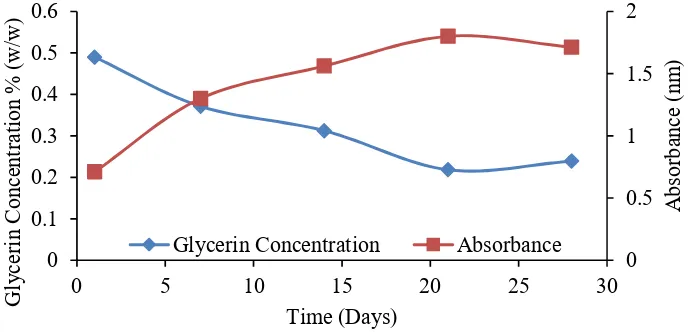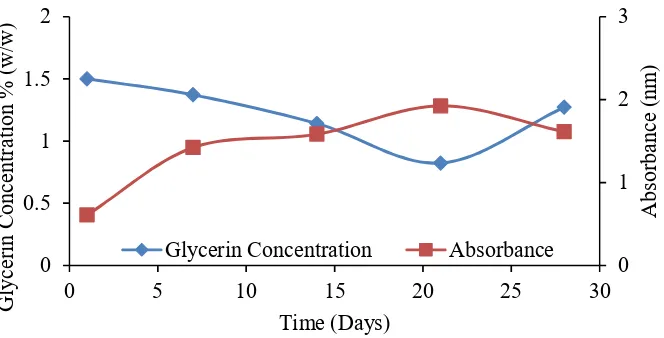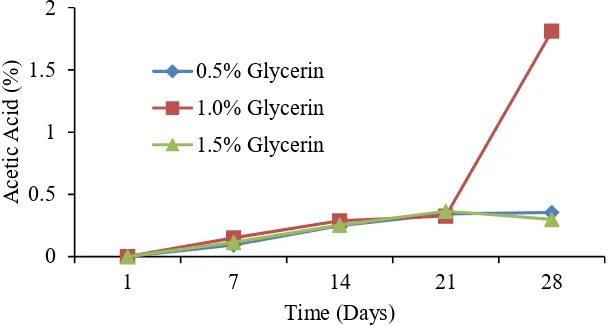IOP Conference Series: Materials Science and Engineering
PAPER • OPEN ACCESS
Fermentative utilization of glycerol residue for the
production of acetic acid
To cite this article: Irvan et al 2018 IOP Conf. Ser.: Mater. Sci. Eng.309 012126
View the article online for updates and enhancements.
Related content
The Influence of Various Factors on the Methane Fermentation Process
M G Kurbanova, E A Egushova and OG Pozdnjakova
-The deep processing of seaweed industrial waste--Influence of several fermentation on seaweed waste of feed
Shipeng Zhao and Shuping Zhang
-Fermentative preparation of functional drink from Punica granatum using lactic acid bacteria and exploring its anti-tumor potential
Shruthi N Murthy, Amie Patnaik, Nandini Srinivasan et al.
1234567890‘’“”
TALENTA-CEST 2017 IOP Publishing
IOP Conf. Series: Materials Science and Engineering 309 (2018) 012126 doi:10.1088/1757-899X/309/1/012126
Fermentative utilization of glycerol residue for the production
of acetic acid
Irvan1,2, B Trisakti1,2, R Hasibuan1 and M Joli1
1Chemical Engineering Department, Universitas Sumatera Utara, Medan, 20155,
Indonesia
2Sustainable Energy and Biomaterial Center of Excellence, Universitas Sumatera
Utara, Medan, 20155, Indonesia
*Email: [email protected]; [email protected].
Abstract. Glycerol residue, frequently known as pitch, is a waste produced from the down-stream product of crude glycerine distillation. With the increasing need of pure glycerine in the world, the glycerol residue produced is also increasing. Glycerol residue is a solid waste at room temperature, highly alkaline (pH > 13), corrosive, and categorized as hazardous and poisonous waste. In this research, acetic acid was produced from glycerol residue through the anaerobic fermentation process by using purple non-sulphur photosynthetic bacteria. The purpose of this study was to find out the influence of concentration change of glycerol residue on time and to find out the possibility of glycerol residue to be utilized as acetic acid. In this research, at first 400 g of glycerol residue was diluted with 200 ml of distilled water to change the glycerine phase, from solid to liquid at room temperature, acidified by using hydrochloric acid until pH 2. The top layer formed was fatty acid and triglycerides that should be removed. Meanwhile, the bottom layer was diluted glycerol residue which was then neutralized with caustic soda. To produce acetic acid, glycerol residue with various concentrations, salt, and purple non-sulphur photosynthetic bacteria were put together into a 100 ml bottle which had been previously sterilized, then incubated for four weeks under the light of 40-watt bulb. The result showed that on the 28th day of fermentation, the produced acetic acid were 0.28, 1.85, and 0.2% (w/w) by using glycerine with the concentration of 0.5, 1.0, and 1.5% (w/w), respectively.
1. Introduction
Oleochemical industries show fast development nowadays. It can be seen from the rise of global palm oil production from 15.2 million tons in 1995 to 62.6 tons in 2015 [1]. By that, glycerol as by product of palm oil also increased from 660.000 tons in 1995 to 1.6 million tons in 2009 [2].
Glycerol also known as glycerin is a neutral, clear, odorless, naturally sweet taste, and viscous liquid. It is derived from both natural and petrochemical feedstock. Glycerin occurs in combined form (triglycerides) in animal fats and vegetable oils and is obtained from these fats and oils during transesterification, such as in biodiesel production. Glycerol is widely used as an additive source in various industries such as textile, food and beverage, pharmaceutical, cosmetic, etc. [3]. Glycerol also can be applied as carbon sources for the fermentation process to produce other various products; one of them is acetic acid [4].
2
1234567890‘’“”
TALENTA-CEST 2017 IOP Publishing
IOP Conf. Series: Materials Science and Engineering 309 (2018) 012126 doi:10.1088/1757-899X/309/1/012126
which previously reacted with sodium and potassium hydroxide at high temperature. This reaction will form polyglycerol which then acetylated by using acetic acid to produce polyglycerol acetate. This final product is used as additive material in making PVC [5].
Other research which already been conducted to handle glycerol from glycerol residue is by the recovery process. This process has several steps such as dilution, acidification, mixing, separation by filtration (giving a crude glycerine with lower dissolved salt and higher glycerol), then neutralization and concentration step. The composition of recovered glycerol was: glycerol 51.4%, ash 13.8%, water 8.9% and matter organic non-glycerol 25.9% [6].
Glycerol as an organic material can be applied as carbon sources together with DL malate. In this research Rhodopseudomonas sphaeorides as the purple non-sulphur photosynthetic bacteria was able to perform glycerol dissimilation process and grew with a doubling time of 6 hours [7]. Purple non-sulphur photosynthetic bacteria (Rhodopseudomonas capsulata) were also able to perform glycerol assimilation process at 30 oC by using a lamp as light source continuously. This assimilation process could increase cell number, dry weight, protein, and bacteriochlorophyll [8]. In this research, glycerol residue was fermented through the anaerobic process to produce acetic acid by using purple non-sulphur photosynthetic bacteria. This fermentation process used a 40-Watt lamp as the energy source, running for 24 hours.
2. Experiment, materials and method
2.1. Experiments
A preliminary experiment was conducted to observe the growth of anoxygenic photosynthetic bacteria in salt and glycerol residue medium at various concentrations: 0.05; 0.1; 0.5% (w/w). The preliminary result showed that higher amounts of purple non-sulphur bacteria grew in medium with concentration 0.5% compared to 0.05 and 0.1%.
Experiments were conducted in Microbiology Laboratory of FMIPA-USU, PT. Wilmar Bioenergi Indonesia Laboratory and BATAN Laboratory.
2.2. Materials and equipment
Main equipment used in this research were Anaerobic Microbiology Mart Culture Jar (series #AJ9023) 2.75 liter of volume, Autoclave Yamato SN 210, Isotherm incubator, 40-watt bulb lamp (Philips). While, reagents and chemicals used were glycerol residue, bromothymol blue indicator, NaOH, NaIO4, H2SO4, ethylene glycol, H3PO4, K2HPO4, KH2PO4, MgSO4.7H2O, FeSO4.7H2O, ZnSO4.7H2O, MnCl2.2H2O, methanol, and hydrochloric acid.
2.3. Method
The raw glycerol residue was obtained PT. Nubika, Permata Hijau Group, Labuhan Batu. All the reagents and chemicals used were analytical grade. All the experiment was performed in triplicate. Experiment procedures consist of six procedures, they are:
1. Separation of fatty acids and triglycerides
1234567890‘’“”
TALENTA-CEST 2017 IOP Publishing
IOP Conf. Series: Materials Science and Engineering 309 (2018) 012126 doi:10.1088/1757-899X/309/1/012126
3. Preparation of Glycerol Residue 0.5%
Glycerol residue 0.5% was prepared by pipetting 4.0 ml of raw glycerol residue into 125 ml bottle, then adding salt media until the volume of the bottle became 115 ml. The bottle was sealed and then sterilized in an autoclave at a temperature of 120 °C with a pressure of 2 bar. After passing through the process of sterilization, the bottle was cooled at room temperature.
4. Fermentation Procedure
Five ml of purple non-sulphur photosynthetic anoxygenic bacteria (PAB) was inoculated in a bottle closed tightly. The bottle was placed in a room equipped with 40-watt incandescent light bulbs. For the preparation, 8.0 and 12.0 ml of glycerol residue of 1.0% and 1.5% were pipetted, respectively and also for 125 ml of 15% glycerol residue into 125 ml volume bottles. Samples were prepared in 12 bottles for each concentration. In the meantime, preparation for control sample did not use glycerol as carbon source. The experiment used only 115 ml of salt medium. The control sample was prepared in 12 bottles.
5. Determination of Acetic Acid Concentration.
Fifteen-μl acetic acid standard with concentration of 0.02, 0.04, 0.06 and 0.08 % were injected into HPLC columns (Shimadzu SPD-6A). The injection was performed by duplicate. The retention time and area of each acetic acid concentration were recorded, in the same way, the samples were injected. The retention time of outgoing sample was recorded. The total area produced by the sample was used to calculate the concentration of acetic acid formed by using linear regression equation analysis.
6. Determination of Microbial Growth, Glycerol Concentration, and pH
Determination of microbial growth was performed by using UV Visible Spectrophotometer (Thermo Spectronis Genesys 5). Glycerol concentration was determined by using titration method. While, measurement of pH was performed by using pH meter (Mettler Toledo S220)
3. Results and Discussion
3.1. Change of glycerine concentration on fermentation time
4
1234567890‘’“”
TALENTA-CEST 2017 IOP Publishing
IOP Conf. Series: Materials Science and Engineering 309 (2018) 012126 doi:10.1088/1757-899X/309/1/012126
Figure 1. Change of 0.5 % glycerine against time
Figure 1 shows the change of glycerine concentration on fermentation time. From Figure 1 it can be seen that visible glycerine concentration decreased from 0.5 to 0.22%. The percentage decrease of glycerine until day 22nd reaches 56.0% from the initial value. The decrease in absorbance values indicates that bacteria lead to the reduction of growth phase due to the reduction of glycerine as the carbon source and the presence of competition during the growth process so that the microbes that are not able to survive will become toxic to other microbes. According to Jawetz, et al., (1996), the accumulation of toxic metabolic outcomes will cause cell growth to stop [10].
The decrease in concentration was also accompanied by an increase in the absorbance value of the sample from 0.614 to 1.814 abs on day 1st until day 21st day with a growth value reaching 2.95 times of the initial absorbance. Glycerine as a carbon source can be utilized by bacteria to grow, marked by an increase in turbidity value from 20 to 150 for 52 hours. This increase in turbidity indicates a larger bacterial population [7].
Growth curves directly formed logarithmic growth without going through adaptation phases. The adaptation phase is likely to start after a few hours through the 1st day. Rhodopseudomonas palustris bacteria grows after a 72-hour incubation period [11]. Meanwhile, bacteria Rhodopsedomonas sphaeraides known as APB bacteria will enter the initial phase or adaptation in the process of glycerol dissemination after going through 6 - 10 hours since the beginning of growth [7].
This study utilized 40-watt lamplight as a source of APB bacterial energy. The 40-watt lamp has a very high light intensity that greatly affects the growth of photosynthetic bacteria. According to Garcia-Contreras et al. (2004), the higher the intensity of the lights, the faster the growth of photosynthetic bacteria [12].
1234567890‘’“”
TALENTA-CEST 2017 IOP Publishing
IOP Conf. Series: Materials Science and Engineering 309 (2018) 012126 doi:10.1088/1757-899X/309/1/012126
Figure 2. Change of 1.0% glycerine solution against time
In Figure 2, 1.0% glycerine solution decreased from 1.01% on day l to 0.22% on day 28 with a conversion rate of 78.2%. The decrease in glycerine concentration was also followed by an increase in bacterial growth value from 0.612 abs on day 1 to 2.344 abs on day 28 with a growth rate of 3.83 times. The decrease in glycerine concentration of l0.0% and the increase in absorbance value of microbial growth showed the highest value compared to glycerine fermentation at 0.5 and 1.5%. Glycerine with a concentration of l.0% can be metabolized up to 97%. The growth pattern of bacteria l.0% is similar to the bacterial growth pattern of 0.5% glycerine. Bacterial growth goes directly to the logarithmic growth phase without passing through the adaptation phase [14].
Figure 3. Change of glycerine concentration 1.5% against time
Figure 3 shows the change of 1.5% glycerine solution on time. As shown from Figure 3, the pattern of glycerine concentration change of 1.5% is almost equal to 0.5% of glycerine concentration. From day 1 to day 21 the concentration of glycerine decreased from 1.49 to 0.83% with the conversion of glycerine change reaching 44.3%. Increasing of glycerine concentration was also marked by the increasing absorbance value of microbial growth from 0.673 abs on day 1 to 1.911 abs on day 2, with a growth value of 2.84 times.
6
1234567890‘’“”
TALENTA-CEST 2017 IOP Publishing
IOP Conf. Series: Materials Science and Engineering 309 (2018) 012126 doi:10.1088/1757-899X/309/1/012126
On the 28th day, glycerine concentration should decrease, but in this study, the concentration of glycerol has increased. This is also indicated by the decrease in the growth absorbance value of the sample that should rise. This problem was possible as well as fermentation of glycerine at 0.5% concentration that is the entry of external air due to less tightening of the bottle lid insulation binder.
3.2 Formation of acetic acid
The formation of acetic acid is the result of glycerine fermentation process initiated by phosphorylation glycerine to glycerol 3-phosphate by ATP derived from light. Glycerine undergoes oxidation or releases a hydrogen atom become dihydroxyacetone then converted to glyceraldehyde which is subsequently oxidized by releasing a hydrogen atom to form pyruvic acid. The pyruvic acid is then reduced to acetic acid [15].
Figure 4 shows the formation of acetic acid at various concentrations. As shown from Figure 4, the highest increase of acetic acid was found at 1.0% glycerine concentration with 1.85% acetic acid concentration on day 28 compared with 0.1% and 1.0%. This indicates that glycerine with a concentration of l0.0% is well utilized by APB bacteria. Glycerine with a concentration of 1% exploited by bacteria as carbon element [14].
Figure 4. Effect of time on formation of acetic acid
3.3 Degree of acidity observation
The setting of neutral pH in the early stages provides good growth on non-sulphur purple bacteria. In Figure 4 shows the degree of acidity of 6.71 and decreased until day 28 for glycerine with a concentration of 1.0%. The decrease in pH was due to the formation of acetic acid and the possibility of other acid acids produced during the fermentation process. Acid compounds are formed from the process of glycerine dissimilation in the form of pyruvic acid, acetic acid, and formic acid, anaerobically [15]. The concentration of glycerine at 0.5 and 1.5% also decreased pH to day 21 with pH values of 3.7 and 3.3. This decrease indicates that the fermentation process is going well, but on the 28th day the pH has increased to 4.4 for both 0.5 and 1.5% concentrations. APB bacteria should still be able to perform fermentation until the pH becomes 2.5 and stop when the pH becomes 2.2 [16]. The increasing in pH is likely due to the disruption of bacterial activity due to the oxygen existence. Other then influences the pH, oxygen also affects changes in glycerine concentration as well as the formation of acetic acid for 0.5% and 1.5% glycerine concentrations.
1234567890‘’“”
TALENTA-CEST 2017 IOP Publishing
IOP Conf. Series: Materials Science and Engineering 309 (2018) 012126 doi:10.1088/1757-899X/309/1/012126
Figure 5. Effect of time on degree of acidity
3.4 Observations on control samples
Observations on control samples aimed to see whether purple non-sulphur bacteria could ferment in the absence of glycerine as carbon elements. Fig. 5 shows that there is no change in pH of acetic acid and absorbance from control sample from day l to day 28. This revealed that no growth or formation of acetic acid occurred in sample.
Table 1. Change on control samples
Time (days)
pH Acetic acid
(% w/w)
Absorbance (abs)
1 6.71 0.02 0.614
7 6.74 0.01 0.608
14 6.78 0.01 0.612
21 6.72 0.05 0.613
28 6.79 0 0.609
4. Conclusion
Glycerine residues of 0.5, 1.0, and 1.5 % concentrations can be utilized by purple non-sulphur photosynthetic bacteria. Glycerine with concentrations of 0.5, 1.0, and 1.5% can be converted to acetic acid. The highest conversion of glycerine to acetic acid was obtained from glycerine residue with a concentration of 1.0% with an acetic acid concentration value of 1.85%.
Acknowledgment
This research was supported by Hibah Penelitian Talenta Universitas Sumatera Utara No: 5338/UN5.1.R/PPM/2017, May 22nd, 2017.
0 2 4 6 8
1 7 14 21 28
p
H
Time (Days) 0.5% Glycerin
1.0% Glycerin
8
1234567890‘’“”
TALENTA-CEST 2017 IOP Publishing
IOP Conf. Series: Materials Science and Engineering 309 (2018) 012126 doi:10.1088/1757-899X/309/1/012126
References
[1] Scientific Advisory Panel 2016 The Palm Oil Story: Facts and Figures, European Palm Oil Alliance, Netherlands
[2] Wendisch V F, Lindner S N, and Meiswinkel T M 2011 Use of Glycerol in Biotechnological Applications, in Gisela Montero G, Stoytcheva M, Biodiesel- Quality, Emissions and
By-Products, InTechOpen
[3] Miner C S, Dalton N N 1952 Glycerol, Reinhold Publishing Corporation [4] Hidawati E N, Sakinah A M M 2011 Int. J. Chem. Environ. Eng, 2 309-313
[5] Yusuf M 2007 Penyediaan poligliserol asetat dari residu gliserol pabrik biodiesel sebagai bahan pemlastis pada polivinil klorida, Master Thesis, Chemistry Department - University of Sumatera Utara
[6] Ooi T L, Yong K C, Dzulkefly K, Yunus W M Z W, Hazimah A H 2001 J. Oil Palm Res. 13 16–22
[7] Pike L, and Sojka A G 1975 J. Bacteriol. 124 1101 – 1105
[8] Lueking D, Tokuhisa D, Sojka G 1973 J. Bacteriol.115 897 – 903 [9] Suryanto D, Suwanto A, Meryandini A 2001 Biotropia 17 9 – 17
[10] Jawetz E, Melnick J L, Adelberg E A, Brooks G F, Butel J S, Ornston L N 1995 Mikrobiologi Kedokteran 20ed. San Francisco-University of California
[11] Getha K, Vikineswary S, Chong V C 1998 World J. Micro. Biotech. 14 505 – 511 [12] Garcia-Contreras R, Celis H, Romero I 2004 J. Bacteriology186 6651 – 6655 [13] Yurkov V V, Beatty J T 1998, Microbiol. Mol. Biol. Rev.62 695–724
[14] Forsberg C W 1987 Appl. Environ. Microbiol.53 639-643
[15] Magasanik B, Brooke M S, Karibian D 1953 J. Bacteriol.66 611-619



